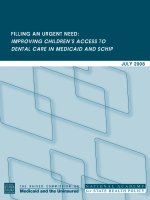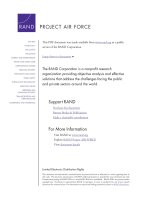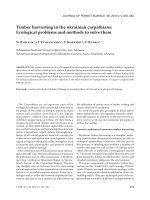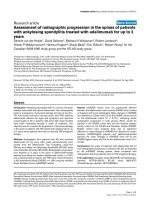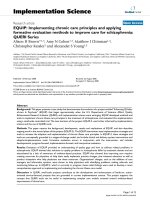Assessment of dental caries status and methods to improve knowledge, attitude, practice of dental care in Military Medical University
Bạn đang xem bản rút gọn của tài liệu. Xem và tải ngay bản đầy đủ của tài liệu tại đây (96.8 KB, 6 trang )
Journal of military pharmaco-medicine no7-2019
ASSESSMENT OF DENTAL CARIES STATUS AND METHODS
TO IMPROVE KNOWLEDGE, ATTITUDE, PRACTICE OF DENTAL
CARE IN MILITARY MEDICAL UNIVERSITY
Dinh Viet Thang1; Nguyen Khang1; Nguyen Phuong Lien1
SUMMARY
Objectives: Assessing the dental caries status and knowledge, attitude, practice of dental
st
th
care of the 1 and the 5 year military medical students; proposing methods to improve
knowledge, attitude and practice of dental care of military medical students. Subjects and
methods: Cross-sectional study was carried out on 380 students of Military Medical University
st
th
(185 of the 1 year students, 195 of the 5 year students) from October 2018 to May 2019.
Results and conclusion: The prevalence of dental caries in Military Medical University students
st
th
was quite low: 28.6% in the 1 year students and 23.1% in the 5 year students. The general
DMF index was 1.005. Distribution of living area was mainly in the countryside (51.32%). The
st
th
general knowledge of good dental care was 4.9% (1 year student); 74.4% (5 year student).
st
th
The attitude of good dental care was 68.1% (1 year student); 89.8% (5 year student). The
st
th
practice of dental care was still bad: 75.1% (1 year student); 72.3% (5 year student).
* Keywords: Dental caries; DMF index; Dental care.
INTRODUCTION
Dental caries is the most common
disease in oral diseases. In recent years,
although the incidence of dental caries
has been improved significantly in developed
and developing countries, including Vietnam
thanks to scientific advances in prevention
and implementation of national dental
school programs. However, dental caries
still accounts for a high proportion,
especially in students.
Military Medical University (MMU) is
the leading medical human resources
training institution for the military. For
odonto-stomatology department, students
of MMU are only equipped with
10 theoretical lessons and 02 weeks of
clinical practice. So far, there has not
been any studies to understand the dental
caries status as well as knowledge,
attitude and practice of dental care, to
propose methods to improve dental care
in these subjects. Therefore, we conducted
this research with aims:
- Assessing the status of dental caries
of the 1st year and the 5th year students at
MMU.
- Assessing the status of knowledge,
attitude, practice of dental care of the 1st
year and the 5th year students at MMU.
- Proposing methods to prevent dental
caries for MMU students.
1. 103 Military Hospital
Corresponding author: Dinh Viet Thang ()
Date received: 10/06/2019
Date accepted: 23/08/2019
95
Journal of military pharmaco-medicine no7-2019
SUBJECTS AND METHODS
teeth; effects of dental floss; period of
regular dental check-up...
1. Subjects.
380 students of MMU (185 of the
1st year students and 195 of the 5th year
students).
The study period was from October
2018 to May 2019 at Department of
Odonto-stomatology and the lecture hall
of MMU.
2. Methods.
- Cross-sectional study.
- Steps to conduct this research:
+ Examining and collecting informations:
Name, age and gender.
+ Clinical examination combined with
questionnaires on knowledge, attitude,
practice of dental care in students.
* Data processing: By software SPSS
version 22.0.
* Group of variables on the knowledge,
attitude and practice of dental care of two
groups:
- Knowledge: About causes of dental
caries; time to brush teeth, how to brush
- Attitude: About the dangers of dental
caries; examination when there is dental
disease; regular brushing; diet which lots
glucose; periodically removing tartar...
- Practice: About brushing teeth (ways
to brush teeth, brushing frequency, time,
time of brushing, how to brush teeth, time
of replacing new toothbrush); using dental
floss; using toothpicks; diet which lots
of glucose; regular dental check-up;
management when there are dental
problems...
To assess the level of knowledge,
attitude and practice of dental care of two
groups, we set the standard that divided
into 3 levels:
- If the answer is correct ≥ 80% of the
points in each section: Good.
- If the answer is 60 - 80% of the points
in each section: Average.
- If the answer is < 60% of the points in
each section: Bad.
RESULTS AND DISCUSSION
Table 1: Some common characteristics of the 1st and 5th year students.
Gender
Ethenic
Area
living
96
st
Total
Characteristics
The 1 year students
th
The 5 year students
Number
%
Number
%
Number
%
Male
321
84.47
169
52.65
152
47.35
Female
59
15.53
16
27.12
43
72.88
Kinh
368
96.84
176
47.83
192
52.17
Minority
12
3.16
9
75.00
3
25.00
Urban
59
15.53
26
44.07
33
55.93
Surbuban
126
33.16
29
23.02
97
76.98
Countryside
195
51.32
130
66.67
65
33.33
Journal of military pharmaco-medicine no7-2019
Parents’
job
Cadres, civil servant
74
19.47
53
71.62
21
28,38
Worker
39
10.26
10
25,64
29
74.36
Medical
50
13,16
10
20.00
40
80.00
Business
100
26.32
57
57.00
43
43.00
Farmer
100
26.32
48
48.00
52
52.00
Housewife
15
3.95
7
46.67
8
53.33
Others
2
0.53
0
0.00
2
0.53
Our research subject was military students, due to the specificity of them, male
accounted for the majority (84.47% male and 15.53% female). Most of the students are
Kinh people (96.84%), this result was similar to the study by Le Nguyen Ba Thu (2012)
[3] (99.5%), the rate of students whose parents doing business and farming occupied a
higher proportion than other groups (26.32%). Living areas are mainly in the countryside
(51.32%). This situation may be affect the conditions and habits of dental care.
Table 2: Distribution of prevalence of tooth caries by gender.
Dental caries
Students
General
st
1 year
5
th
year
No dental caries
Gender
p
Number
%
Number
%
Total
98
25.8
282
74.2
Male
85
22.4
236
62.1
Female
13
3.4
46
12.1
Total
53
28.6
132
71.4
Male
49
26.5
120
64.9
Female
4
2.2
12
6.5
Total
45
23.1
150
76.9
Male
36
18.5
116
59.5
Female
9
4.6
3
1.5
< 0.05
< 0.05
< 0.05
The rate of dental caries was 28.6% in the 1st year and 23.1% in the 5th year. This
result was lower than other studies. Trinh Dinh Hai [1] (2005) studied 3,181
Vietnamese adults, the rate of dental caries was 87.5%. Truong Manh Dung [2] (2005)
studied in the ages of 18 - 45, the rate of dental caries was 68.6%. This result was due
to the fact that our study subjects are medical students who have good knowledge of
dental care than others.
97
Journal of military pharmaco-medicine no7-2019
Table 3: Distribution of DMF index.
Decay
Missing
Filling
DMF
M+F
(M + F)/DMF
D/DMF
p
st
0.562
0.07
0.529
1.166
0.599
51.3%
48.6%
< 0.05
th
5 year
0.333
0.148
0.369
0.845
0.517
61.18%
38.81%
General
0.447
0.109
0.449
1.005
0.558
56.24%
43.7%
1 year
Our result was lower than other studies. According to Truong Manh Dung [1] (2005),
the DMF index was 2.84; F Maatouk's study [4] on medical students with an average
age of 22.7 showed that the DMF index was 2.32. This result showed that the dental
care, treatment and preservation of tooth decay of MMU students were quite good.
Table 4: Comparison of the level of knowledge about dental care of the 1st year and
the 5th year students.
Students
st
Level
th
The 1 year
p
The 5 year
Number
%
Number
%
Good
9
4.9
145
74.4
Average
73
39.5
44
22.6
Bad
103
55.7
6
3.1
185
100
195
100
Total
< 0.05
The proportion of students in the 5th year was higher than the 1st year at a good level
(74.4% compared to 4.9%), the rate of the 1st year students was higher than 5th year
students at the bad level (55.7% compared to 3.1%). This difference was statistically
significant with p < 0.05. This showed the effectiveness of the teaching knowledge of
dental care for students when they studied odonto-stomatology in the 5th year. This
result was similar to the study by R Neeraja [5] on 250 dental students in Bangalore,
India: The 3rd year students with good knowledge of dental care were better than the
first and the second year students, differences were statistically significant with p < 0.001.
Table 5: Comparison of the level of attitude about dental care of the 1st and the
5th year students.
Students
st
Level
th
The 1 year
The 5 year
Number
%
Number
%
Good
126
68.1
175
89.8
Average
55
29.7
17
8.7
Bad
4
2.2
3
1.5
185
100
195
100
Total
98
p
< 0.05
Journal of military pharmaco-medicine no7-2019
The proportion of students with good and average attitude of dental care in the
5 year was higher than in the 1st year (98.5% and 97.8%). This result was similar to
the study by Le Nguyen Ba Thu [3] (2012). Thus, it can be seen clearly effectiveness
before and after studying odonto-stomatology of two groups.
th
Table 6: Comparison of the level of practice of dental care of the 1st year and the
5th year students.
Students
st
Level
th
The 1 year
p
The 5 year
Number
%
Number
%
Good
7
3.8
9
4.6
Average
39
21.1
45
23.1
Bad
139
75.1
141
72.3
185
100
195
100
> 0.05
Total
The results showed that > 70% of students who practices dental care at a bad level,
but this difference was not statistically significant with p > 0.05. This result was similar
to study by Le Nguyen Ba Thu [3] (2012).
CONCLUSION
* Dental caries status of subjects:
- The proportion of dental caries was
quite low: 28.6% in the 1st year; 23.1% in
the 5th year, mainly in countryside and the
students’ parents are farmer, business.
- The DMF index was generally low
(1.002). The DMF index of students in the
1st year was higher than in the 5th year
(1.166 and 0.845).
- The proportion of dental caries had
not been treated in the 1st year students
higher than the 5th year students (48.6%
and 38.81%).
* Status of knowledge, attitude and
practice of dental care of subjects:
- Knowledge: General knowledge about
dental caries of both research groups at
good level was 4.9% in the 1st year
students; 74.4% in the 5th year students.
- Attitude: The proportion of students
with good dental care attitude was 68.1%
in the 1st year and 89.8% in the 5th year.
- Practice: Both groups of students had
a high rate of badly practical skills (75.1%
in the first year; 72.3% in the 5th year).
* Some methods to improve knowledge,
attitude and practice of dental care in
MMU students:
Through the above research results,
we offer some methods to improve
knowledge, attitude, practice of dental
care in MMU students:
- The MMU should organize examination,
care, dental consultation, tartar scaling for
students every 6 months.
99
Journal of military pharmaco-medicine no7-2019
- The MMU should add to the learning
program content and practice of dental
care.
- The MMU should invest in building
skill labs for students to practice dental
care skills before going to practice in
hospitals.
REFERENCES
1. Trịnh Đình Hải. Sâu răng ở người
trưởng thành. Tạp chí Y học Việt Nam. 2005,
1 (306), tr.7-11.
2. Trương Mạnh Dũng. Khảo sát thực trạng
bệnh sâu răng và hành vi chăm sóc bệnh
răng miệng của người dân xã Xuân Quang,
100
Chiêm Hóa, Tuyên Quang năm 2011. Tạp chí
Y học Thực hành. 2011.
3. Lê Nguyễn Bá Thụ. Thực trạng bệnh
sâu răng và kiến thức, thái độ, thực hành về
vệ sinh răng miệng của học sinh trung học cơ
sở tại thành phố Buôn Ma Thuột, tỉnh Đắk Lắk
năm 2012. Tạp chí Y học Việt Nam. 2012, 2
(407), tr.89-93.
4. F Maatouk, W Ghedira et al. Effect of 5
years of dental studies on the oral health of
Tunisian dental students. Eastern Mediterranean
Health Journal. 2006, 12 (5), pp.625-631.
5. R Neeraja et al. Oral health attitudes
and behavior among a group of dental students
in Bangalore, India. European Journal of
General Dentistry. 2011, 5, pp.163-167.

